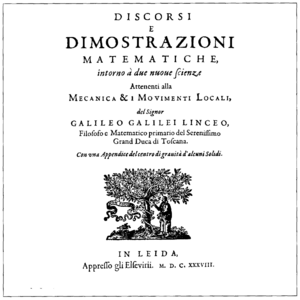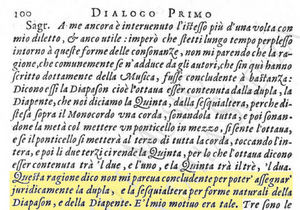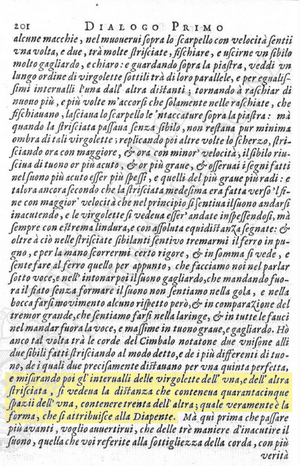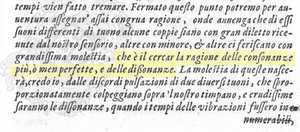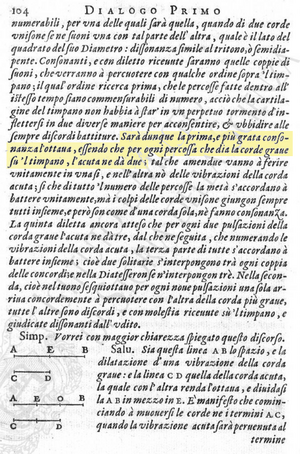Aspetti fisici e matematici en
Da "Fisica, onde Musica": un sito web su fisica delle onde e del suono, acustica degli strumenti musicali, scale musicali, armonia e musica.
Jump to navigation Jump to searchConsonance of simple ratios: physical or metaphysical?
The page From monochords to musical scales briefly reviews the origin of various musical scales. The determination of the structure of these scales in various eras and civilisations has been based more on "aesthetic" considerations, established by practice and judgement of the consonance of intervals, rather than considerations taken from a real understanding of the sound phenomenon. Even Pythagoras's research, which some consider to be an early version of the experimental method, was not such, since the experimental recognition of "simple ratios" of consonant sounds was used to develop a type of metaphysical (almost numerological) picture. For the modern scientist, for whom Galileo is the paradigm, the discovery of a link between "simple ratios" of the lengths of the parts of a monochord and the consonance of the two sounds produced, once we have established that sound is a physical entity, must have an origin connected to the modality of production and perception of sounds. Let us see what Galileo himself said[1]
What determines the pitch of a note?
Galileo's explanation
Continuing in the dialogue, Galileo clearly showed that the length of a string cannot be the only aspect for "sufficiently establishing" the pitch of a note. With a series of experiences, he showed that "...There are three different ways in which the tone of a string may be sharpened, namely, by shortening it, by stretching it and by making it thinner...".
At the same time, Galileo claimed to have observed an increase in the frequency of observed ripples in a glass struck by "tremors" emitted by a tuning fork. This observation caused Galileo to think that the fundamental aspect for determining the pitch of a sound is the frequency of its oscillations. He was tempted, albeit aware of the difficulty of counting the vibrations of an oscillating string (it is believed that this number is hundreds of vibrations per second!), to jump to conclusions and say that the sound in an octave is due to double the number of vibrations. However, being faithful to his experimental method, he could not accept claims that were not confirmed by experience. He devised a method to accurately "measure" the ratio of the frequencies of two sounds that still amazes us with its ingenuity to this day. Once again, we quote Galileo directly:
The modern explanation
From a physicist's point of view, a musical instrument is a system that generates sound waves and radiates them into the environment. In particular, it is composed of (at least):
-
- a vibrating element (string, membrane, plate, air, etc.) tuneable to various frequencies;
- a resonator that amplifies the vibrations and gives a shape to the sound waves;
- an impedance adapter between the vibrating system and the surrounding air.
- The formation of stationary waves in the vibrating parts of musical instruments is explained in detail on the pages Interference between reflected waves and Sound reflection . The geometric characteristics of these parts (string length, sound tube length, etc.) determine the selection of specific wavelengths.
- However, knowledge of selected wavelengths is not enough to explain the pitch of emitted sounds. To do this, as Galileo intuited (from the preceding text emerges Galileo's extraordinary ability to investigate nature and to grasp its unifying aspects), it is necessary to know the oscillation frequency of the vibrating parts.
As explained on the page How is a wave described?, the calculation of the frequency of an emitted sound also requires knowing the speed with which the wave is propagating along the vibrating element based on the formula:
This speed depends on the physical characteristics of the vibrating element; in particular:
- in the case of strings, both the string tension (which is what we vary when we "tune" a guitar) and "thickness" (the thinner the string, the faster the wave travels). The guitar's first E generates a very high frequency sound because the generating string is thin and very taut. When Galileo spoke of ways to "sharpen the tone", today we could say that he actually meant to change the propagation speed of the mechanical waves of the vibrating element.
- in the case of sound tubes (in which the air particles are made to vibrate by the musician), the pressure and density of the fluid contained in the sound tube.
When a musician plays an instrument, they generate desired sounds by modifying the geometric characteristics of the vibrating element (except in wind instruments, where the musician can select more notes by modifying the pressure of the air flow without modifying the sound tube length):
- a violinist shortens and lengthens a part of the vibrating string creating a fixed end with their finger;
- a flautist modifies the "actual length" of the sound tube by opening and closing specific holes.
It is preferable that the physical characteristics remain unaltered; however, we often see violinists retuning their instruments "on the spot" by finely adjusting string tension (the quality of an instrument is also measured by its ability to stay in tune). In the case of monochords, tuning is obviously stable (i.e. the speed does not change for at least the time of the execution of the two sounds) and therefore
- The ratio between the sound frequencies is completely determined by the ratio of the lengths of the vibrating parts that generate it or as Galileo said "...I assert that the ratio of a musical interval is not immediately determined either by the length, size or tension of the strings but rather by the ratio of their frequencies, that is, by the number of pulses of air waves which strike the tympanum of the ear.
[Ed. Note: bold text is ours] In particular, as there exists a direct proportionality between the wavelength and length of the vibrating part (i.e. λ=k l ), we can write:
Theory of consonance
Similitude of Galileo's pendula
Having established that the ratio between sound frequencies is completely determined by the ratio of the lengths of the vibrating parts that generate it, Galileo tried to justify the reasons for consonance in the simplicity of ratios between frequencies of emitted sounds. In a very famous passage from Discourses Relating to Two New Sciences" (1638), Galileo attributed the origin of consonance to the fact that when two sounds of commensurable frequencies (according to small ratios) reach the ear, the latter perceives a regularity of the phenomenon that repeats in a period of brief duration. In this passage, Galileo strengthened his argument with a mechanical similitude: two pendula that were made to oscillate in synchrony and completed an oscillation in 2 and 3 seconds respectively would quickly recover their synchrony (after six seconds, the minimum common multiple between two and three). If the ratio of the frequencies is not commensurable (inconceivable for the first Pythagoreans but not for the last!) or if it is expressed by fractions containing large numbers (e.g. 9/8), recovery of synchrony will happen only after nine pulsations of the more frequent note rendering the ear unable to recognise the regularity (and, therefore, the consonance) of the phenomenon. Let's see what Galileo said about this:
To give strength to his argumentations, Galileo introduced his famous similitude of pendula to explain how even our vision can be confused by the observation of the oscillation of two pendula that do not have commensurable frequencies according to simple ratios.
Von Helmholtz's consonance theory
However inspiring and wisely argued Galileo's theory may be, it is incomplete for three reasons:
- the first is that the perception of consonance between two sounds does not only depend on the ratio of their frequencies but also on the absolute value of the frequencies themselves. For example, in instruments with a wide range, an interval of a minor third (ratio 6:5) appears to be less consonant in the lower range of the keyboard (i.e. at lower frequencies);
- the second is that, in Galileo's reasoning, sound is characterised by a single frequency (to put that in modern terms, a pure sound). As discovered after Galileo (visit the page Fourier's Theorem), when a string vibrates (if you want to see how, visit the page on wave synthesis), it emits a composite sound composed of a principal wave (called the fundamental, which determines the perceived frequency) and waves (called partials) having frequencies that are all multiples of the frequency of the fundamental. This is a consequence of the selection mechanism of wavelengths;
- the third is physiological: attributing the sensation of consonance to the regularity of the vibrations of the tympanum is evidently an extrapolation, if we do not know how this mechanical vibration is processed by the brain.
Hermann von Helmholtz created a theory of the perception of sounds that allows us to partially overcome the three abovementioned difficulties.[2]
- As explained on the page How is a musical scale constructed?, at low frequencies, sounds with the same frequency ratio are very close in frequency. Von Helmholtz claimed that sounds with very close frequencies induce dissonance because they cause very close nerve fibres to generate confusion in brain processing. This is the phenomenon of beats described from a physiological point of view on the page regarding critical bands.
- Von Helmoltz attributes the emergence of dissonance to the beats between high order partials if they fall within a critical band. As the width of a critical band increases with an increase in frequency, sounds with a large content of high order harmonics can be self-dissonant. You can experiment with this fact directly by synthesising sounds of this type in our virtual laboratory.
- Galileo's intuition to attribute consonance to the regularity of the vibrations of the tympanum was actually not too far from the truth, even in more recent explanations. Sounds with frequency ratios expressed by simple numbers, have frequent coincidences in their high order partials (e.g. the third harmonic of C is identical to the second harmonic of G, which is one fifth higher) and activate the same receptors. It is as if the nerve fibre "map" activated by C were also partially contained in the nerve fibre "map" activated by G. This fact is confirmed by the subjective amount of consonance that we attribute to two sounds (e.g. a fifth) emitted by an instrument poor in overtones (e.g. the flute) or by an instrument rich in overtones (e.g. the piano). In the second case, sound appears more harmonious, as if the Galilean "synchrony" were strengthened by the coincidence of the partials.
A possible conclusion
However, we must not believe that von Helmholtz's theory offers an objective criterion for establishing a hierarchy of consonant sounds. Today, physicists, musicians and acoustic engineers are trying to find the laws that unequivocally establish this hierarchy. However, the underlying problem that renders much of this research in vane or questionable is that the amount of major or minor consonance depends on so many parameters that they cannot be kept under scientific control (the musical context, the register in which the musical instruments are playing, the relationship between instruments with different timbres, etc.) making any type of univocal determination almost impossible (perhaps luckily!).
In-depth study and links
- The admirable method with which Galileo experimentally controlled his intuition to link the pitch of a sound to the frequency of the sound itself, shows us that one of an experimental physicist's concerns is this: how to measure "something" when the technology for that "something" does not yet exist? If you want to learn about the ingenious method that Newton used to measure the speed of sound, visit this page.
- If you want to read a musicians point of view on the issue of consonance-dissonance, visit this page. On the page about Psychoacoustic and musical aspects, you will discover that the issue of consonance-dissonance is part of the greater issue of the creation of a harmonic syntax. In this wider context, the issue cannot be addressed without referring to the "functional" aspects that the various groups of notes (chords) play within the modality chosen for their concatenation.
- ↑ Galileo Galilei, Discourses and Mathematical Demonstrations Concerning Two New Sciences Relating to Mechanics & Local Motion by Mr. Galileo Galilei, Leiden, 1638. Images of the original text are taken from a digital copy in the Institute and Museum of Science History in Florence, Italy and are available at Biblioteca Digitale. An English translation can be consulted at [1]
- ↑ Hermann L. F. von Helmholtz, Die Lehre von den Tonempfindungen, als Physiologische Grundlage für die Theorie der Musik, Vieweg, Braunschweig, fourth edition, 1877. English translation by Alexander J. Ellis, On the Sensation of Tone as a Physiological Basis for the Theory of Music, Longman & Co., 1885, reprinted by Dover, New York, 1954. Visit this link to see a complete reproduction of the third edition in German (1870).


